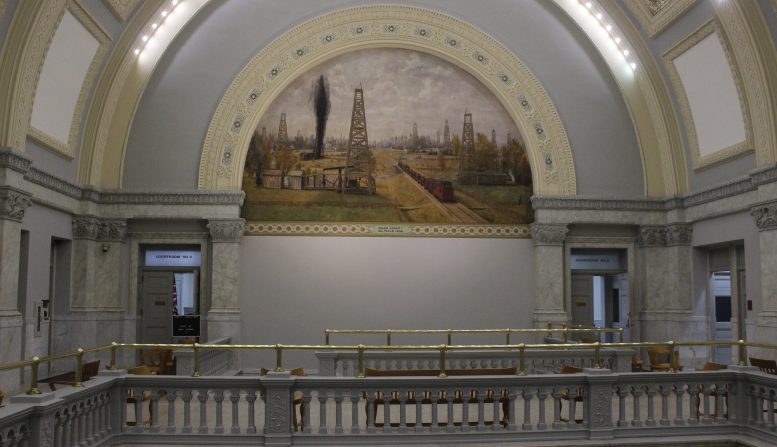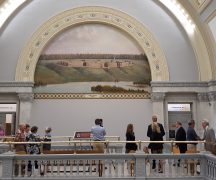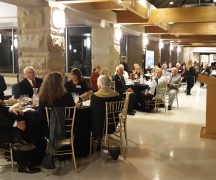By JAN LARSON McLAUGHLIN
BG Independent News
For more than a century, the murals on the top floor of the Wood County Courthouse have caused heads to tip back in admiration of the artwork.
The county commissioners would like courthouse visitors for years to come to have that same experience.
So the commissioners are planning to spend nearly $70,000 to restore the works of art.
“That building is on the National Register of Historic Places,” said Wood County Administrator Andrew Kalmar. And the murals are an integral part of the structure. “They depict scenes from Wood County a century ago.”
The county commissioners are expected on Tuesday to enter into a contract for $21,980 to lease scaffolding for the restoration project. Earlier this fall, they had approved a contract for $47,390 to hire McKay Lodge Conservation Laboratory Inc., from Oberlin, to restore the murals.
The work will be laborious and tedious – taking an estimated four weeks for each towering mural.
The scaffolding will go up on Nov. 26, with a tentative completion date of Feb. 1, 2019.
Putting up the scaffolding in itself is a difficult job.
“We’ve had it done before, for painting the trim,” on the courthouse’s third floor, Kalmar said. “Unfortunately, that’s a major portion of the costs for whatever we do there.”
The commissioners were told earlier this year that the aging murals were at a critical point. A painting restoration expert said it’s now or never for the massive murals.
“You’re at the turning point,” Kalmar said the county was informed. “If we don’t do restoration now, they are going to start coming off the walls.”
The murals depict Fort Meigs in 1813 on the east wall, and an oil field in 1904 on the west wall. The murals were painted * by I.M. Taylor, an artist and mayor of Bowling Green.
A couple years ago, workers restoring plaster at the courthouse noticed some paint flaking on the murals. So the county contracted with ICA Art Conservation, a non-profit center in Cleveland for advice. Andrea Chevalier, a senior painting conservator, visited the courthouse to get a close look.
She saw large areas where the paint is peeling, yet still precariously hanging onto the surface. There are also a few areas where the paint is gone altogether.
The surfaces of the paintings are actually quite clean, without a film of dirt, nor heavy varnish. However, there were traces of nicotine from the time when smoking was allowed in the building.
Chevalier said that to fix the murals an adhesive will have to be applied under the surface using a hypodermic needle or brush. Then a special packing press will be used to flatten the flaking paint back onto the surface.
The areas where the paint is gone will be filled in and repainted to match the original.
While not by a famous artist, they are competently painted. she said, and definitely worth preserving. “They’re part of the cultural heritage of the city and the county.”
And the county commissioners consider it their responsibility to preserve the stately building.
“It’s the role the commissioners have played over the decades,” Kalmar said. The county’s predecessors built this beautiful, ornate courthouse, he said, “And they have to take care of it.”
*The story originally stated the murals were painted in 1910-11, but those dates have been called into question.




